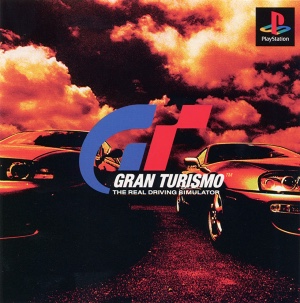Gran Turismo (1997 video game) facts for kids
Quick facts for kids Gran Turismo |
|
|---|---|

Japanese cover art featuring a Nissan Skyline GT-R (left) and a Toyota Supra (right)
|
|
| Developer(s) | Japan Studio (Polys Entertainment) |
| Publisher(s) | Sony Computer Entertainment |
| Director(s) | Kazunori Yamauchi |
| Producer(s) | Kazunori Yamauchi Shuhei Yoshida |
| Designer(s) | Kazunori Yamauchi Takeshi Yokouchi Hirotaka Komiyama |
| Programmer(s) | Seiichi Ikiou |
| Artist(s) | Masaaki Goto |
| Composer(s) | Masahiro Andoh (JP) Isamu Ohira (JP) Jason Page (EU/US) |
| Series | Gran Turismo |
| Platform(s) | PlayStation |
| Release date(s) |
|
| Genre(s) | Sim racing |
| Mode(s) | Single-player, multiplayer |
Gran Turismo is a 1997 racing simulation video game developed by Japan Studio's Polys Entertainment (later called Polyphony Digital for North American releases and sequels) and published by Sony Computer Entertainment for the PlayStation. It was directed by Kazunori Yamauchi and produced by Shuhei Yoshida. It is the first game in the Gran Turismo series.
After five years of development time, Gran Turismo was well-received both commercially and critically, shipping a total of 10.85 million copies worldwide (making it the best-selling PlayStation game), and scoring an average of 95% in GameRankings' aggregate, making it the highest rated racing video game at the time of the site's closure in 2019. Many publications have deemed it one of the greatest video games of all time. The game has started a series, and has spawned over 10 spin-offs and sequels.
Gameplay
Gran Turismo is a racing game. The player must maneuver a car to compete against artificially intelligent drivers on various race tracks. The game uses two different modes: Arcade Mode and Simulation Mode (Gran Turismo Mode in PAL and Japanese versions). In the arcade mode, the player can freely choose the courses and vehicles they wish to use. Winning races unlocks additional cars and courses.
However, simulation mode requires the player to earn different levels of driver's licenses in order to participate in events, and earn credits (money), trophies and prize cars by winning race championships. Winning one particular championship also unlocks a video and a few additional demonstration tracks. Credits can be used to purchase additional vehicles, and for parts and tuning.
Gran Turismo features 140 cars and 11 race tracks (as well as their reversed versions). Two Honda NSX cars from 1992 were included in the Japanese version, but were removed from the North American and European versions. There is also a 1967 Chevrolet Corvette and a 1998 Mazda Roadster exclusive to the Arcade mode.
Development
The game took five years to complete with a development budget of $5 million. The development personnel were largely the same team which was behind the earlier PlayStation racers Motor Toon Grand Prix and Motor Toon Grand Prix 2, and Gran Turismo uses parts of the Motor Toon game engine, such as the physics model. Kazunori Yamauchi said that the development of Gran Turismo started in the second half of 1992. Yamauchi added that at different times only seven to fifteen people were assisting him. Since Motor Toon Grand Prix 2 was still in development when work on Gran Turismo started, several people only joined the development team after the completion of Motor Toon Grand Prix 2 freed them up to work on Gran Turismo. Shuhei Yoshida, at the time head of Japan Studio, was the producer of the game.
When asked how difficult it was to create Gran Turismo, Yamauchi remarked: "It took five years. In those five years, we could not see the end. I would wake up at work, go to sleep at work. It was getting cold, so I knew it must be winter. I estimate I was home only four days a year." While the team used standard PlayStation libraries in part, to get the game to run at optimal speed they had to use assembly code, and even then, they found the limitations of the PlayStation's CPU would not allow them to meet their initial goal of having 12 cars in each race. Sound design was one aspect that Yamauchi believed was compromised due to a lack of time. Although Kazunori considered the game's artificial intelligence to be superior to its competitors, he remained unsatisfied with its development.
Gran Turismo was the first game designed to fully support the PlayStation's DualShock controller.
When Gran Turismo was released in Japan, Polys Entertainment was still a development group within Sony Computer Entertainment's Japan Studio. The studio was reestablished as Polyphony Digital in April 1998, before the Western release of the game. Yamauchi estimated that Gran Turismo utilised around 75% of the PlayStation's maximum performance.


